Volume 3 Number 1
©The Author(s) 2001
The Combine Project: An Experience in a Dual-Language Classroom
Abstract
This article describes what happened when a bilingual kindergarten class in West Liberty, Iowa, investigated a combine. The dual-language program supports content area instruction in both Spanish and English. The first part of the article tells the story of the Combine Project, this class's first project work. The story begins with a typical kindergarten field trip to a farm and ends with a parent night to show a combine constructed by the kindergartners. The second part of the article discusses the teacher's reflections on learning how to guide projects. Reflections by the teacher include relating kindergarten goals to projects, supporting second-language learners, involving parents, and including children with special needs.
School and Background Information
The students involved in the Combine Project were in a bilingual kindergarten class in West Liberty, Iowa. The kindergarten class meets full day for 6.5 hours. The day is divided into approximately 1.5-hour increments, not including recesses or lunch, in which the language spoken in the classroom is either Spanish or English. For example, on Monday, the class begins in Spanish, switches into English right before lunch, and ends in Spanish toward the end of the day. The next day, the pattern is repeated, but the class begins in English.
The class population is diverse, consisting of 11 native English speakers and 10 native Spanish speakers. The goal of the bilingual program, for both Spanish and English speakers, is maintenance of native language development while learning a second language. There are children with Individualized Education Plan (IEP) goals integrated into the class: one with a severe language delay, requiring a full-time aide, and another with Asperger's Syndrome. All of the children were able to participate in and contribute to our work on the Combine Project.
The Project Approach was first used in the dual-language kindergarten last year. This year, 2000-2001, I began with an informational night for parents on the Project Approach. The informational night was held about three weeks into the school year. The parents were given a short presentation on how the Project Approach works, how it fits into the standard school curriculum, and how they could help support this method of learning. After the presentation, parents were invited to walk around the classroom and look at documentation from the projects the kindergarten class had completed last year.
The Combine Project
Project Background: Phase 1
Our project began with a trip that all the kindergarten classes in our school district take to a nearby farm every fall. During a group discussion with the children, we made a web on large chart paper, indicating their thoughts about the farm and what they thought they might see on our visit. After their visit to the farm, I used a different-colored marker to record their new contributions to the web. Many of the children's new comments were related to the animals they had seen on the farm. However, one child thought of a tractor as an additional idea to include in our web; this addition led another child to think of corn. The comments they were sharing with me rapidly started turning into questions about the process of growing corn and the tractors. At this point, I decided to follow their new interest in grain farming, rather than animals, and arranged a visit to Billie Danner's farm to watch soybeans being harvested by a combine. (Mr. Danner is the father of a child in my class. After the informational night on the Project Approach, he had told me we would be welcome to visit his farm any time.) Figure 1 shows my initial teacher planning web. The main focus of the project became farm machinery.
 Figure 1. Teacher planning web.
Figure 1. Teacher planning web.
Before going to the Danner farm, the children asked many questions about what they thought we might see during the visit to the farm. To help jog their memory of the initial farm field trip, I replayed a video that one of the parents had recorded. I found the video to be a very useful tool to prompt discussion.
The following questions were generated by the children after our first field trip to a farm before we had done any field site visits. In order to help the children see what might be appropriate to ask Mr. Danner on our field site visit, I separated the questions into those having to do with livestock and those having to do with grain farming. Many of the questions about animal behavior and births were answered by children before visiting the Danner farm, mostly through reading nonfiction literature. The questions involving what animals eat, which greatly interested the children, were answered by Mr. Danner on our field site visit when he brought out buckets of animal-grade corn and explained which animals ate it.
Livestock (Animal) Questions
McKayla/Jorge: Why do pigs eat corn?
Jessica: Why do horses gallop? What do horses eat?
Irving: What do cows eat?
Kathy: How much corn do animals eat?
Payton: How do cats get babies?
Morgan: Why do pigs roll in the mud?
Lolita: What do sheep eat?
Breanna: Do cows eat the same things as dogs?
Daniel: Why do cows drink milk?
Michelle/Josh: What do you feed a chicken besides grass?
Ariel: What do horses eat?
Alexis: What sound does a goat make?
Questions We Could Ask Mr. Danner (Grain Farming)
Bianca: How many people are in the farmer's family?
Anahi: How many wheels do the tractors have?
Christian: How long does corn grow?
Kennedi: How do you drive a tractor?
Javier: How do you get the corn out (of the ground) when it's ready for eating?
Tracy: How much does a tractor cost?
In preparation for our visit to the Danner family farm, a tally sheet was introduced to the children during a math lesson. The children were given photos of John Deere tractors and combines, as well as tally sheets of possible items they might be able to count on the machinery. The tally sheets included pictures and written words for wheels, lights, and windows. Those items were chosen because most children were sufficiently familiar with them to be able to locate them on the machinery. I handed each child a picture of the equipment, and they made marks for the number of items they saw. This activity was met with great enthusiasm by the children. The tally sheet below is one they used during our visit to the Danner farm.
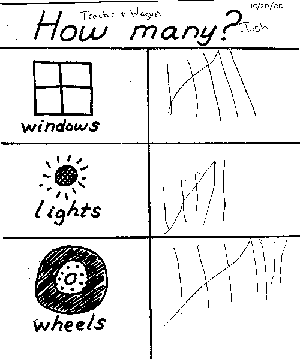 Figure 2. Josh's tally sheet from the Danner farm.
Figure 2. Josh's tally sheet from the Danner farm.
Before the visit, I called Mr. Danner and read the children's questions to him over the phone. During the phone call, such details were discussed as where the children were going to stand and what he could demonstrate. It was decided that following the demonstration of the combine actually harvesting soybeans, he would take the children up into the combine a few at a time, while the rest of the small groups took some time for observational drawing.
Investigation: Phase 2
The visit to the Danner farm went very well. Mr. Danner met us at school and led the school bus out to a field he was in the process of harvesting. He knelt down at the children's level and began by pointing out the front of the combine and showing them the soybeans he was harvesting by breaking apart a soybean pod. The children were fascinated by this demonstration and continued to collect soybeans and the pods, which I encouraged them to save for further examination in our science center in the classroom. After briefly answering the children's questions related to grain farming, Mr. Danner began to harvest the soybeans with the combine as we watched. He was very careful to drive straight into the middle of the field so that we could see the harvesting path he was making by its contrast to the tall soybean plants yet to be harvested on either side of the path. The amount of dust produced was incredible! The children ran for cover behind a truck when the combine first took off. But they peeked out to watch the combine as it circled around and began its return to us. A silence fell over the group. At first, I was concerned that the dust had scared them, but soon their excited, high-pitched voices filled the air as they began talking and asking questions. Upon his return, Mr. Danner was immediately bombarded by questions from the children.
Two parent volunteers had accompanied us on the visit to the farm. The bilingual kindergarten aide and the aide for our severely challenged student also joined us on the trip. It was previously arranged for each of the adults to take a group of five to six students. Each adult had a tote bag with a clipboard for each child, a list of the children's questions, pencils, and the tally sheets. The adults chose which piece of farm equipment to take their groups to, and the children were off! One group went to the smaller tractor and wagon, two groups went to a large transport truck with an auger, another began to draw the front of the combine, and one group went up into the combine. The interest and attention spans of the children surprised many of the adults. All of the groups were very engaged, some with the tally sheets and others with making observational drawings. The same parent who videotaped our earlier trip to a farm also videotaped the visit to the Danner farm. Some good examples of the children actively engaged in field study can be seen on the following video.
View video 1
Mr. Danner explains to the children what the combine is used for and how it operates. He shows them soybeans and explains what they're used for. Then he drives the combine across the field as the children watch (approximately 5 minutes 30 seconds).
Transcript:
MR. DANNER: And this is some of the equipment that we use to do it. And this is one of the farms that we do it on. We've got many farms around in the area. This is the truck that we use to haul the grain away to take it to a bin.
TEACHER: … ponen el grano despues de recojerlo y lo ponen alli para llevarando en esta carte en este combino grande.
( … they put the grain after harvesting it and they put it there for carrying it in this bin in this big combine.)
MR. DANNER: We raise different kinds of grain. We raise soybeans.. . . We raise corn. It takes it in through here. This goes to the ground. It lowers and it's got a whole bunch of knives out in front here that cuts it off. And this thing helps push it in. It pushes it in the machine. And gathers it all to the center and pushes it through. Then the combine smashes the plant and rolls it. And inside these—we call these pods. Inside there's beans in there. . . . The machine separates it. We've got a whole bunch of them.
TEACHER: Can you pass it? Pass it to another person.
CHILD: There's a whole bunch of them.
TEACHER: Go up and see if you can get some of the beans. . . . It's OK. There's some in there.
TEACHER: What is in your hand? Can you tell …?
CHILD: Soybeans.
TEACHER: What do they grow in? A bean pod?
CHILD: Yeah.
TEACHER: Let's come sit back down. Now that you've got your beans, sit back down, so we can …
CHILD: I've only got one of them.
TEACHER: That's OK.
TEACHER: We're going to sit back down and see what else …
CHILD: I want my beans back.
MR. DANNER: This is feed for next year.
TEACHER: OK, he was right that they use some of them for planting.
TEACHER: What do you think they use these for?
MR. DANNER: Some of them … you'll find that when you go to the grocery store, like vegetable oil. The beans, when they process them, they get oil, vegetable oil out of them. So a lot of your vegetable oils come from soybeans. It's used for proteins for animals.
TEACHER: Do animals eat it?
MR. DANNER: Yes.
TEACHER: So sometimes animals eat it. A veces los animales lo comen. A veces hacen cosas como aceite. Hacen aceite.
(Sometimes animals eat it. Sometimes they make things like oil. They make oil.)
MR. DANNER: Some of these are for human consumption. For soy milk or soy burgers. Some beans are used for … they're using soybeans to make diesel fuel now. And certain oils. There's many, many uses for soybeans. I don't even know them all.
[The combine goes across the field. The children follow.]
CHILD: The dust is in our eyes already.
TEACHER: That's OK.
[The combine comes to a stop, and Mr. Danner climbs down.]
View video 2
Mr. Danner stops the combine, then he and the children discuss the combine and the crops. The children take notes and make drawings (approximately 4 minutes 13 seconds).
Transcript:
[Mr. Danner gets down from the tractor after driving it across the field.]
TEACHER: That was cool, wasn't it? Did you see it move? Did you see the teeth move?
[The children talk. Mr. Danner explains the operation of the combine. The children gather around buckets of corn.]
TEACHER: Take a big step back so we can explain what it is. Big step back.
TEACHER: Eso es que se llama maiz blanco.
(That's what's called white corn.)
That's what you just looked for?
MR. DANNER: That's what was in those pods. And that's yellow corn for livestock.
TEACHER: Eso no se come la gente. No se come la gente. Se comen los animales esto.
(People don't eat that. People don't eat it. Animals eat that.)
CHILD: I want to eat this.
TEACHER: We're not going to eat it. We're just feeling it right now.
TEACHER: Ya contaron todas las ruedas? Que mas van a contar?
(Did you count all the wheels? What else are you going to count?)
CHILD: Las luces.
(The lights.)
TEACHER: … contar la luz despues?
(…counting the lights after?)
MR. DANNER: You guys want to look inside?
[The children count the parts of the combine: wheels, headlights, etc.]
CHILD: Una …
One, two…
I made eight of them.
TEACHER: Muy bien. Donde estás? (Very good. Where are you?) Oh, there you are. Y las luces? (And the lights?)
CHILD: Now do we get to count the lights?
[Children take notes and make drawings.]
Que ???? adentro?
MR. DANNER: These lights going out to the side show you where your last mark has been when you're doing spring work out in the field. That's the benefit of them. Then there's the light at the end of the auger up there that helps you when you're unloading into the trucks.
TEACHER: There's the lights flashing.
MR. DANNER: It lights up and lets you know how full the truck is.
OTHER FARMER: Did he explain how you drive along side and pick up the beans?
MR. DANNER: No, not really.
TEACHER: Do you know what this tractor is for?
CHILD: Yeah.
TEACHER: What?
[Child answers.]
TEACHER: That's right, in the back wagon, right?
OTHER FARMER: The combine doesn't have to stop moving. This cart can pull along side while the combine is going through the field, and the combine dumps his load onto this cart here. And then this'll take it to the truck.
TEACHER: Did you know that? That's how they did it? You want to get down so somebody else can get up?
CHILD: I found all of them.
OTHER FARMER: Show them where the horn's at. They can each honk the horn.
After our visit to the Danner farm, our project really took off. Immediately after watching the combine harvest the soybeans, the children were filled with questions. I noticed a greater amount of detail in their questions after our visit to the Danner farm compared with their questions prior to the visit. Some of their earlier questions about the tractors resurfaced, eventually leading to our visit of a local tractor and combine dealership. The questions below were generated by the children after revisiting their combine trip by watching it on the video.
Farm Questions after Combine Visit
Anahi and Jorge: How do the soybeans and corn grow?
Javier: How do you drive the tractor?
Kathy: When do you plant the corn?
Morgan: How big is the combine?
Josh: Where do combines get their gas?
Daniel: How many knives are there inside (the combine)?
Jessica: How many days to grow a soybean?
McKayla: Where do you make the wheels for the tractor?
Bianca: How many soybeans do they get?
Lolita: How come they get the soybeans?
Irving: How many wheels did the combine have?
Tracy: Where do you buy a tractor? How do the soybeans grow? When do they get big?
Christian: How do they plant the soybeans?
Alexis: Where does the corn come out of (on the combine) after they pick it?
Breanna: When do the balls come off of the soybeans (when they're picking it)?
Kennedi: Where do the combines take the corn?
Materials for their investigation continued to be provided in the classroom. Communication was also continued through letters with Mr. Danner about some of the children's questions. The Iowa Soybean Promotion Board was contacted, and they sent more information and materials about soybeans. Many of the children's questions continued to be about the combine itself: how it worked, how many wheels it had, and so forth. This interest prompted the arrangement of another visit for the class, this time to a tractor dealership.
I called a local dealership of Case, an international producer of tractors and combines. H.D. Cline was the name of the dealership located in West Liberty and owned by the Cline family. The owners seemed a little hesitant at first about the visit but in the end decided to let us come. I made a personal visit the day before our field site visit. The kind of work the children would be doing there was discussed with the employees and the management. Two demonstrations were planned for the children to watch: replacing a tractor light bulb and replacing screws in the wheel with an air wrench. Back in their classroom, the children planned teams of who wanted to study which area at H.D. Cline. Four interest groups were formed: one to focus on a study of wheels, another on lights, a steering wheel/computer group, and another to focus on the front of the combine.
The children really enjoyed the visit. The advance planning was very helpful. The employees knew exactly where they wanted the children to sit and conducted the demonstrations in an appropriate length of time for them. The employees also surprised us with an additional demonstration of the removal of a damaged motor from a combine. They even let all the children climb to the top of the combine to see where the motor used to be. At the end of the visit, they provided each of the children with a model tractor to take home and some outlines of combines to color. The outlines of the combines were used for a classroom writing activity described later in this article.
During Phase 2 of the project, there were many ways the children continued investigating combines. The following examples are taken from documentation panels shared with the parents at our culminating event, a night when the families came to school to learn about the children's experiences. One panel focused on the process of project work, explaining it to parents by grouping activities under the following categories: demonstration, investigation, drawing, narration, and questioning.
Demonstration. Demonstrations observed by the children during field site visits are a key part of the Project Approach. Demonstrations give children something tangible to focus on and remember, rather than just giving them information verbally. Morgan, 5 years old, reflects on watching the combine: "The combine was moving and we got dirt on our face and it cut the soybeans when it was moving" (see Video Clip 1). Children watched the combine harvesting soybeans at the Danner farm. They later watched a demonstration by H.D. Cline employees of putting the bolts into a wheel (see Figure 3).
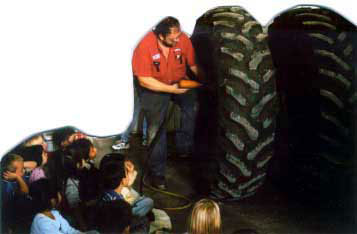 Figure 3. H.D. Cline demonstration.
Figure 3. H.D. Cline demonstration.
Investigations. Hands-on investigation was an essential part of the children's learning about the combine. On our visit to the Danner farm, Mr. Danner let the children play in buckets of soybeans, animal-grade corn, and food-grade corn (see Figure 4). At H.D. Cline's, the children were allowed to climb to the top of the combine and see where the soybeans are stored. Breanna reflects on her climb to the top of the combine: "Estoy subiendo con Paquito para mirar las cosas de elote que estaban adentro la cosechadora. Estoy mirando las semillas arriba." ("I'm climbing with Paquito, to watch the things of corn that were inside the combine. I'm watching the seeds on top") (see Figures 5 and 6).
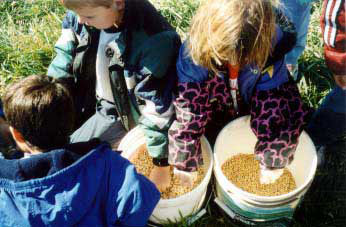 Figure 4. Children playing in the buckets of corn.
Figure 4. Children playing in the buckets of corn. 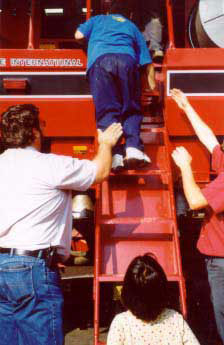 Figure 5. Climbing the H.D. Cline combine.
Figure 5. Climbing the H.D. Cline combine. 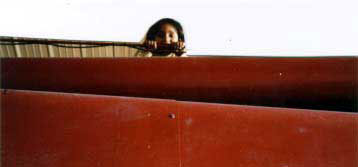 Figure 6. Breanna on top of the combine looking down.
Figure 6. Breanna on top of the combine looking down.
Drawing. Drawing is a child's way of taking notes during a field visit. Just as we write notes to help us remember things, a child's drawing can help him or her remember. Comparing a child's repeated drawings allows us to see what they have learned over time. Payton, age 5, reflects on drawing the front of the combine: "I was drawing the teeth. Morgan was drawing the same thing. The big teeth were for chomping the beans" (see Figure 7). The sketch in Figure 8 was drawn by Javier at the Danner farm on October 12. The sketch in Figure 9 was drawn by Javier in our room on October 20. Javier's final wheel sketch, showing both front and back wheels and the bolts, was drawn at H.D. Cline's on November 1 (see Figure 10).
 Figure 7. Payton and Morgan drawing.
Figure 7. Payton and Morgan drawing. 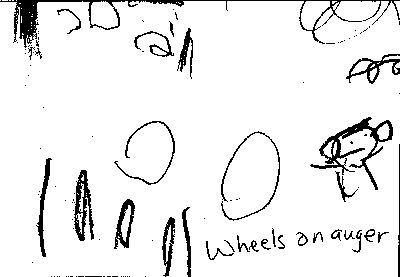 Figure 8. Sketch by Javier (October 12).
Figure 8. Sketch by Javier (October 12).  Figure 9. Sketch by Javier (October 20).
Figure 9. Sketch by Javier (October 20). 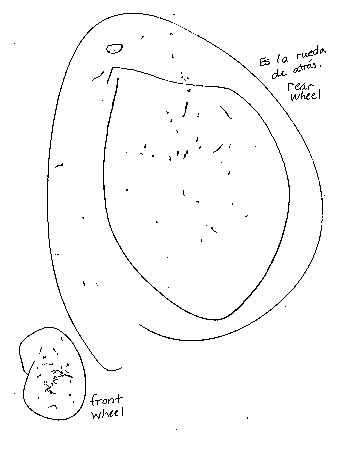 Figure 10. Sketch by Javier (November 1).
Figure 10. Sketch by Javier (November 1).
Narration. A narration of the events in the Combine Project helped our class remember exactly what they experienced. The narration also helped them to reflect on their own learning. The following was dictated to me by the children on the day after our trip to the Danner farm: "We went to the farm on the bus. We saw 1 tractor and 1 combine. We saw some trucks, and Javier drew the part that gets the corn back there (auger). The combine was green and yellow, 'cause that's what it's supposed to be. The combine was really big. We climbed a ladder to get to the top of the combine."
Questioning. By generating their own questions, children took ownership in their project work on the combine. Throughout the project, our class was constantly asking questions. Mr. Danner took the time to answer the children's questions during our field site visit (see Figure 11). Christian was curious about how many pieces were on the front part of the combine. He counted the corn headers and wrote down the numerals to find the answer (see Figure 12). McKayla's question was, "Where do you make the wheel for a tractor?" She asked this question of an employee from H.D. Cline and remembered it all by herself. I wrote down his answer, "It comes from a store, and we bring them here to put them on tractors." McKayla was very intent upon copying down the answer and drawing it out (see Figure 13).
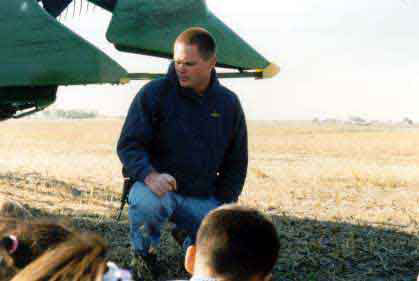 Figure 11. Mr. Danner answering questions.
Figure 11. Mr. Danner answering questions. 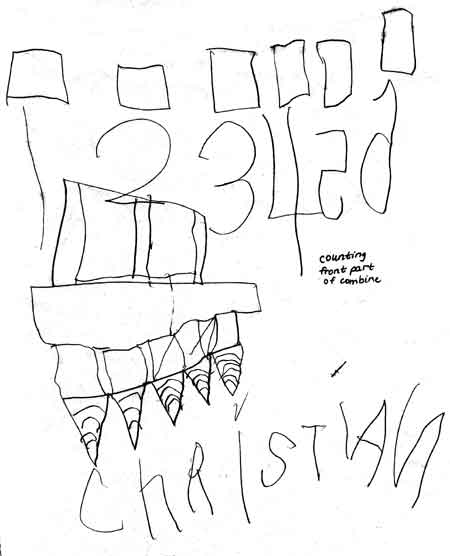 Figure 12. Christian's question.
Figure 12. Christian's question.  Figure 13. McKayla's question.
Figure 13. McKayla's question.
Representation
During the weeks in between our two field site visits, investigation continued in our classroom. Before visiting H.D. Cline, the children were very involved in choosing exactly what they were interested in examining. They signed up for different teams to examine various parts of the machinery. For example, we had a wheel team, a lights team, and a steering wheel-computer buttons team. After our field site visit to H.D. Cline, the children were shown some documentation of other projects, and we discussed what they wanted to do with their new knowledge about combines. It was decided that they would build a combine in their classroom. The children made a list of what is needed to make a combine and signed up for various jobs, many based on their teams from our field site visit to H.D. Cline. Almost all of the children in the class signed up for a job; several people signed up to make two different things for the combine. The class planned to begin construction the following Monday; two children remembered all weekend and brought special materials for our combine construction. The following paragraph explaining the construction of a combine wheel is an example of the documentation placed on the combine they built to share with parents for our family night:
Lolita drew the wheels of the combine at a field site visit (see Figures 14 and 15). Back in our room weeks later, Lolita and Lexi constructed wheels after examining drawings and photos (see Figures 16 and 17).The combine was constructed in about a week during center time during the afternoons. After our construction was completed, they only played in the combine for two days. Based on this observation, and the length of our project, I decided it was time to culminate the project.
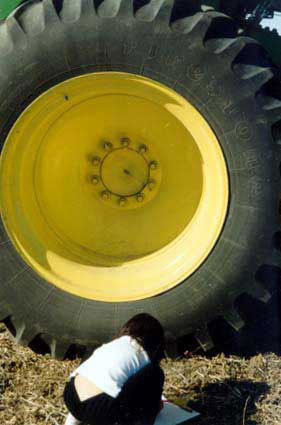 Figure 14. Lolita sketching.
Figure 14. Lolita sketching. 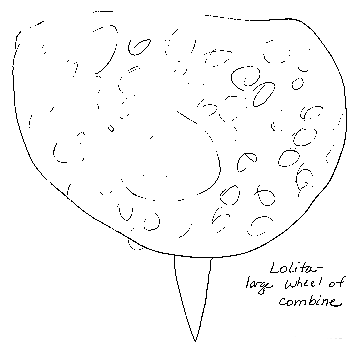 Figure 15. Lolita's sketch of a wheel.
Figure 15. Lolita's sketch of a wheel. 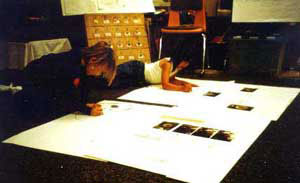 Figure 16. Lolita and Lexi studying photos and sketches of a wheel.
Figure 16. Lolita and Lexi studying photos and sketches of a wheel. 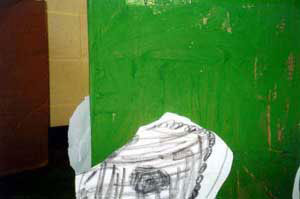 Figure 17. Finished wheel by Lolita and Lexi on the combine.
Figure 17. Finished wheel by Lolita and Lexi on the combine.
Culmination: Phase 3
The children gathered together, and I began a discussion of how they could culminate the project. Several possibilities were listed, and they were most excited about showing their parents their work. I spoke with the principal and planned a family night for our class. We marked it on the calendar, and the children counted down the number of days until our "Combine Party," as it came to be known. The family night was a successful way to conclude our project and is explained in greater detail later in this article. Two documentation panels, "How We Learned in the Combine Project" and "Meeting Kindergarten Goals in the Combine Project," were shared at the family night. The combine itself was used as documentation by making tent cards that explained how each part of the combine was made (see Figure 18).
 Figure 18. Example of a tent card from family night.
Figure 18. Example of a tent card from family night.
The children were very excited about our family night. The documentation panels were completed early and brought into our classroom two days before the event. During center time, the children had a chance to find their contribution to the project on the boards or on the tent cards attached to the combine they had constructed and to practice how they would show it to their families. Twelve families came to our family night, including grandparents, aunts and uncles, and neighbors. This attendance was the best of any home-school event during this school year. Almost half of the participants were Spanish-speaking families. At the family night, evaluations were also provided for the parents to fill out on the Project Approach in our classroom. Shown in Figures 19 through 21 are some photographs of parents looking at the documentation of the Combine Project.
 Figure 19. Families looking at a display.
Figure 19. Families looking at a display.  Figure 20. Kennedi's mom looking at a display.
Figure 20. Kennedi's mom looking at a display. 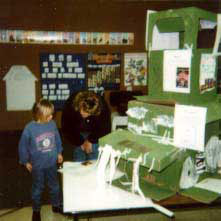 Figure 21. Lexi showing her mom her wheel part of the combine.
Figure 21. Lexi showing her mom her wheel part of the combine.
Teacher Reflections
Parental Involvement
Much of the success of this project was due to the support and interest of the parents. Parents were involved in many ways during our Combine Project. I held a Project Approach information night, encouraged parents to volunteer, and held a family night to celebrate the construction of the combine.
I held a Project Approach information night early in the school year, about two weeks after the school year had begun. Ten families came to the meeting, representing about half of my students. For our school, this number is considered an expected turnout for home-school events. For example, nine families came to our schoolwide open house. I was pleased to see that about one-third of the participants were Spanish-speaking parents from our room. I gave a brief overview of how the Project Approach works, how we could meet many of our kindergarten curriculum goals through a project, and how they as parents could support us in our project work. I had the parents write down their professions and hobbies to keep in mind for future projects.
Following the project informational night, I had many parents volunteer to help with the project. Two parents who attended the informational meeting later began volunteering in our classroom on a weekly basis. Both of those parents also decided to come along with us on our field site visit to see the combine working at the Danner farm.
One of those parents said she could videotape our field site work. She videotaped the preliminary field trip that we went on with the other kindergarten classes. That videotape was well done, so I showed her some tips from Windows on Learning (a book by Judy Harris Helm, Sallee Beneke, and Kathy Steinheimer published in 1998 by Teachers College Press) about using videos in project work, such as focusing on big pieces of equipment that might seem overwhelming for the child to look at. She did a wonderful job, and we were able to refer back to the video throughout our project work. The video allowed us to revisit our trip to the Danner farm, and the children watched it before generating a new list of questions two days after our field site work. The video also enabled us to do time-two drawings, right in our own classroom, of their observational sketches from our original field site work. The details provided by the video were also helpful for construction of the combine.
Meeting Curriculum Goals
One of my primary concerns throughout the course of the project was addressing our curriculum goals. This concern stemmed partially from the fact that I was given a West Liberty Foundation Grant for using the Project Approach, and I wanted to be careful to demonstrate to the trustees of the grant how effective the Project Approach can be in reaching academic goals in the classroom. Second, I wanted to demonstrate to parents how much their children were actually learning during the project and how well the Project Approach ties in with our standard curriculum.
I began by using the Teacher Planning Web (see Figure 1) to brainstorm a list of possible ways a Farm Project might fit into the curriculum. The initial web, of course, narrowed down as the topic narrowed. I tied the areas from the planning web as much as possible to the lesson plans. I also kept a list of goals from our report card close at hand to use while writing lesson plans. There were so many places where our kindergarten curriculum goals could be met through our Combine Project! For the documentation panels at family night, I selected examples from the domains of literacy, mathematics, and science. I wanted the goals to be clear to viewers, so I listed the goal being met right below the example of the child's work.
One goal we worked on was mathematics: understanding the values of numbers 1-10 (see Figure 2). Another mathematics goal explored was writing numerals 1-20. Javier wanted to represent that there were four screws in the tractor light. He drew four dots and wrote the numerals, 1, 2, 3, 4 (see Figure 22). During the Combine Project, Anahi became interested in the gauges inside of the tractor. She spontaneously copied down several large numbers to represent the 18 gauges (see Figure 23).
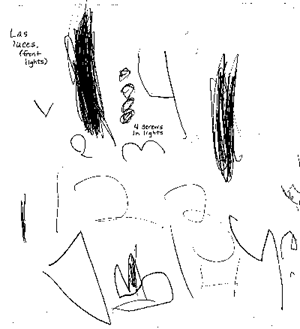 Figure 22. Javier counting lights
Figure 22. Javier counting lights 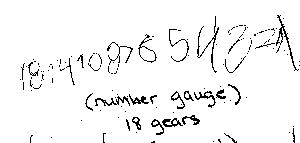 .
Figure 23. Anahi's tractor gauge.
.
Figure 23. Anahi's tractor gauge.
Many literacy goals were shared with parents as well. One important literacy goal in kindergarten is one-to-one tracking of words when reading. While writing thank-you notes to H.D. Cline, Michelle went to the chart paper and carefully touched each word while writing it. She wanted to be sure to have it just right for the thank-you note (see Figure 24). Another kindergarten literacy goal is using known letter sounds while writing. Using copied pictures of a combine that H.D. Cline had donated, I asked the children if they would be interested in labeling some of the parts of the combine. They practiced saying the words slowly and listening for sounds (see Figures 25 and 26). We also worked with the literacy goal of understanding that print has meaning. After a field site visit, I shared the pictures with our class, and they told me what was happening in each picture. Kathy became very interested in what I was writing, so I let her do her own writing about the picture. She wrote, "We were watching," and "There are 8 bolts in the wheel" (see Figures 27 and 28).
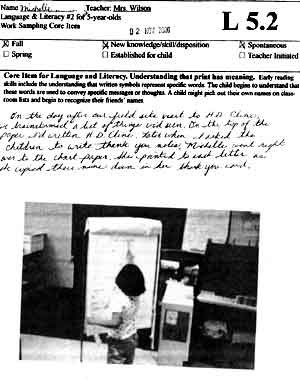 Figure 24. Work sampling: Michelle.
Figure 24. Work sampling: Michelle. 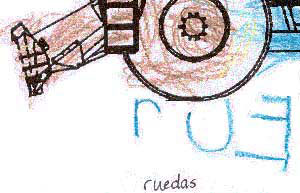 Figure 25. Spanish labeling: Daniel.
Figure 25. Spanish labeling: Daniel. 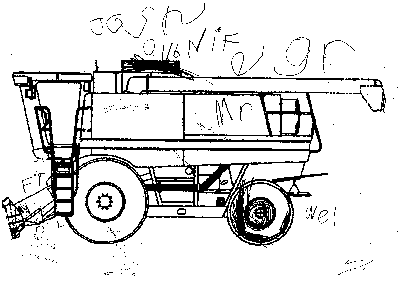 Figure 26. English labeling: Josh.
Figure 26. English labeling: Josh. 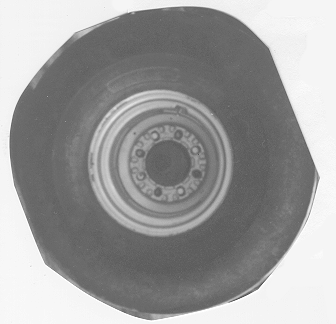 Figure 27. Wheel with 8 bolts.
Figure 27. Wheel with 8 bolts.  Figure 28. Writing: Kathy.
Figure 28. Writing: Kathy.
Involving Children with Special Needs
One of the most rewarding aspects of using the Project Approach in my classroom was the participation of Paquito, a special needs student. Paquito is classified as a child with severe special needs and requires a full-time classroom aide. His verbal skills are about at the level of an older 2-year-old or very young 3-year-old. His receptive language is greater than his expressive language. There are a few words he uses repeatedly to express needs or wants, such as "bathroom" or "teacher." Most often when a question or decision is required of him, he repeats the question back but does not verbalize an answer.
I knew that certain aspects of the project could be beneficial to him, such as our field site visits and the hands-on investigation; yet there were other areas of the project work and his involvement that concerned me, such as the questioning or child-led decisions about the culminating event. Paquito participated fully on our field site visits. He did observational drawing on his own and with assistance could do the tally sheets for various parts of the tractor. He made project dictionaries with our class, in which they copied words from our word wall that they wanted to be able to spell for their project work and drew pictures to go along with the words. When we signed up for what we wanted to study on our visit to the tractor dealership, Paquito was able to point to the drawing I had of the steering wheel. Later, however, when we decided to sign up for teams for the construction of our combine, Paquito did not choose to be on any team.
During center time in our room, children who had signed up to construct a piece of our combine went to our dramatic play area to begin construction. Other children whose team was not yet needed, or who chose to go to other centers, simply told me where they would play for that particular day. When it was his turn to choose what to do, Paquito chose to go to the combine. I hesitated because I was worried that he might not know what to do and because I was worried about the other children's reaction to his presence during construction. I decided that it was unfair not to send him, so I let him to go to combine area. I was so pleased to watch Josh, another child in our class, take Paquito under his wing. Josh was attempting to tape his steering wheel onto the side of the combine. Josh told Paquito to go and get his scissors and showed him how to cut the tape where he needed it cut. Josh and Paquito worked together for about 20 minutes, cutting the tape to attach the steering wheel. Not only was Paquito able to participate in construction, he helped construct the very part which had interested him during our visit to the tractor dealership! I further explained this story to parents on tent cards displayed with our combine for family night (see Figure 29).
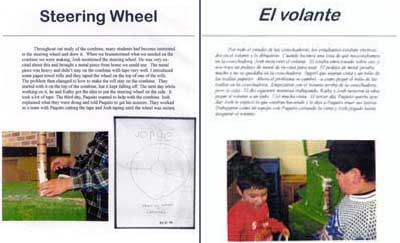 Figure 29. Sign from combine about Paquito and Josh on the steering wheel.
Figure 29. Sign from combine about Paquito and Josh on the steering wheel.
Teacher Evaluation of the Project
Through our Combine Project, I learned many things about the process of doing a project. The topic of combines and farm machinery was an appropriate topic, both meaningful and relevant to the children's lives. It certainly reflected the background of my students in rural Iowa. Four children in my class came from farming families. The topic also was successful because it occurred during the harvest season. Children could observe farm machinery working all around them. Furthermore, the topic worked well because there is a lot for the children to both draw and examine on combines. It was a concrete topic for them.
The children gained much of the content knowledge and skills that I had hoped they would gain. Both the mathematics and literacy goals integrated easily with our project work. The only area where I wished I could have done more was with the actual products that come from soybeans or corn in Iowa. We got soybean crayons from the soybean promotion board, but I would have liked to bring in some other products (such as oil) for them to see. Bringing in products could have helped the children complete the harvest process in their minds by seeing the end result. Bringing in additional soybean or corn products would have also enabled me to tie in more social studies and science goals. At the beginning of the project, I prioritized the integration of literacy and mathematics curriculum goals. Despite the fact that I could have included more goals in other disciplines, overall I was pleased to note how many curriculum goals I was able to include.
I am also pleased with how well the Project Approach fit into the special considerations of a dual-language classroom. The hands-on experiences provided a rich background for vocabulary development of second-language learners. Motivation was high in both Spanish and English speakers to understand what I was reading in their second language when it related to our Combine Project. I also noticed an increased level of communication between the Spanish-speaking and English-speaking children. This communication level was especially high during the construction of our combine. One young English speaker, for example, wanted to be sure that his Spanish-speaking companion knew what to do, so he said, "Go get your tijeras (scissors)." When children planned to ask questions of an expert in their second language, they worked diligently to pronounce the words carefully to be sure they were understood. Furthermore, I noticed parents of different language backgrounds communicating more about their children's work at our family night than at previous home-school events.
During the Combine Project, I also had the opportunity to acquire new knowledge about the individual phases of the project. I learned that in Phase 1, when trying to web the children's prior knowledge, they often generate questions; I could have written down their questions on a different sheet of paper while we were webbing instead of waiting to record their questions until later. In Phase 2, I experienced the benefits of going to visit a field site before taking the class. I think our field site visit went smoothly due to my preliminary visit and resulted in a richer experience for the children. In Phase 3, I incorporated the children more in planning events than I had in previous project work. I noticed that as a result, the children were more excited about the family night, and that excitement contributed to a large number of families attending.
In Conclusion
The Combine Project provoked a lot of thought for both my children and me. I began to feel that something exceptional might be occurring in my classroom after a conversation I participated in over lunch. A few of my colleagues were complaining about their children being excited about the upcoming Thanksgiving vacation. I commented that my students did not seem very wound up about the holiday this year. Another teacher, whose grandchild is in my classroom, commented, "I'll tell you what your kids are wound up about—it's that Combine Project of yours!" What a great thing it is to be wound up about learning and investigating in kindergarten!Author Information
Rebecca A. Wilson teaches kindergarten in the Dual Language Program at West Elementary in West Liberty, Iowa. The program focuses on maintaining native language development, while learning a second language, and serves children from kindergarten to fourth grade. Rebecca has a B.A. double degree in early childhood education and Spanish from the University of Northern Iowa. She continues to learn about the Project Approach and apply it to her classroom teaching.
Rebecca WilsonWest Elementary School
111 W. 7th St.
West Liberty, IA 52776
Telephone: 319-627-4243
Email: rwilson@westlibertyschools.com
For more information about the Project Approach, please visit https://illinoisearlylearning.org/pa/

